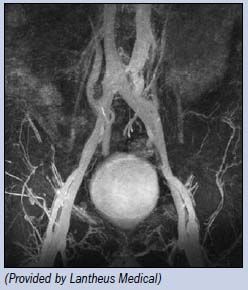Lantheus' blood pool agent lights up your life
Ablavar, the only commercially available blood pool MR contrast agent, lights up vasculature in this steady-state MR angiogram.

Ablavar, the only commercially available blood pool MR contrast agent, lights up vasculature in this steady-state MR angiogram. The agent entered the U.S. market early this year under the auspices of Lantheus Medical, a provider of ultrasound and nuclear medicine imaging agents. A different company, Epix Pharmaceuticals, had developed the agent, however, under the name Vasovist, and won FDA approval in December 2008 after a long struggle with American regulators.
Epix sold the U.S., Canadian, and Australian rights to market the agent to Lantheus in April 2008 for $28 million in a futile attempt to stay afloat after the company had switched its focus to the development of therapeutic drugs. Epix declared bankruptcy a year ago.
Its unique injectable MR angiography agent is approved by the FDA to evaluate aortoiliac occlusive disease in adults with known or suspected peripheral vascular disease, producing high-resolution images with a single dose. Ablavar's albumin-binding properties allow the agent to persist in circulation for an extended time, illustrating vascular anomalies in both dynamic (first-pass) and steady-state imaging.
Emerging AI Mammography Model May Enhance Clarity for Initial BI-RADS 3 and 4 Classifications
May 21st 2025In a study involving over 12,000 Asian women, researchers found that an artificial intelligence (AI) model converted over 83 percent of false positives in patients with initial BI-RADS 3 and 4 assessments into benign BI-RADS categories.